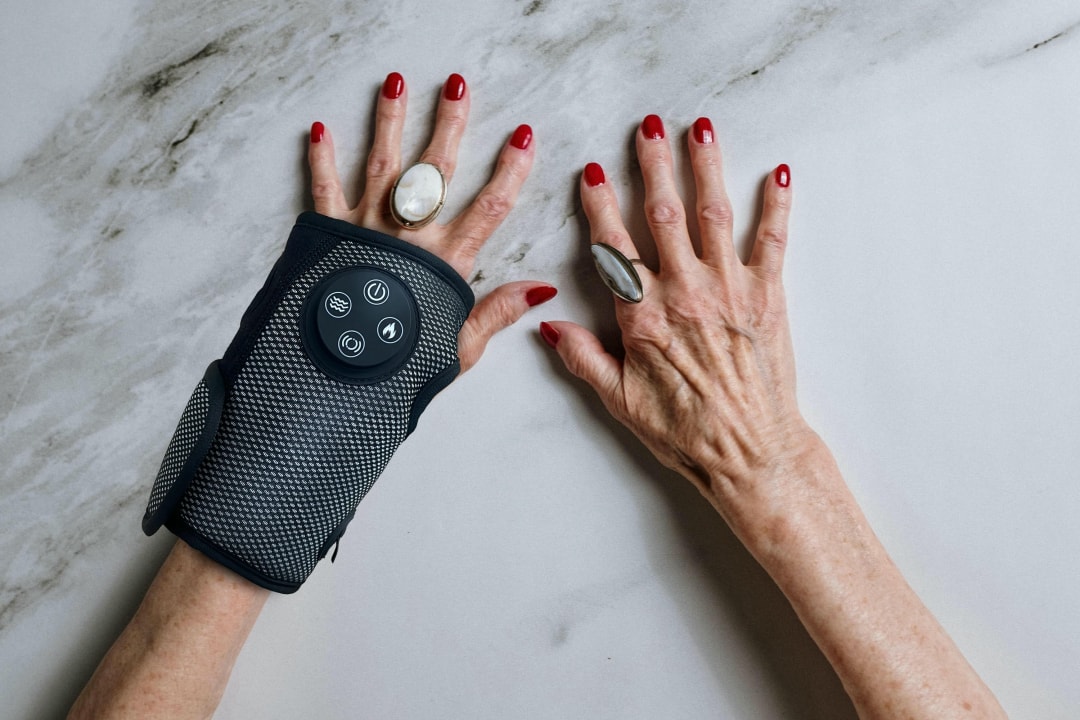Do Hand Massagers Help Musicians, Climbers and Office Pros?
- By Grace
- Updated on
In our modern world, where keyboards and smartphones dominate our daily lives, our hands are often the unsung heroes, enduring endless tapping, swiping, and gripping. It's no wonder that many of us, especially those in demanding white-collar roles, find ourselves asking: "Can a hand massager truly offer relief from the aches, fatigue, and stiffness that build up over time?" This isn't just a casual query; it's a genuine search for comfort and improved well-being. As your dedicated health coach, I'm here to explore the fascinating world of these devices, delving into the science, the experiences of various users—from diligent desk workers to adventurous mountaineers—and the nuanced perspectives on their effectiveness.
Whether you're battling everyday soreness or exploring ways to support recovery, understanding how a hand massager works, and who truly benefits, is key. We'll unpack the different features, weigh the reported advantages against skepticism, and discuss how these innovative tools fit into a holistic approach to hand health and alleviating persistent hand pain. Let's get into the nitty-gritty of hand wellness.
Understanding Hand Pain and Fatigue: Why Our Hands Suffer
Our hands are incredibly complex, housing a delicate network of bones, muscles, tendons, and nerves, all working in intricate harmony. For many white-collar professionals, these intricate systems are put under constant, often repetitive, stress. Think about the countless hours spent typing at a computer, gripping a mouse, or endlessly scrolling on a smartphone. This sustained, low-level strain can lead to significant muscle fatigue, stiffness, and even discomfort that radiates throughout the hand and wrist. It's a subtle but persistent problem that often goes unnoticed until it becomes a nagging ache or persistent throbbing.
Beyond daily grind, specific conditions can emerge from this repetitive stress. Early signs of issues like tingling, numbness, or a general feeling of weakness in the hands can signal something more significant, such as the beginnings of carpal tunnel syndrome. While a hand pain massager is not a cure for such clinical conditions, understanding the root causes of everyday hand discomfort is the first step toward finding effective relief and preventative strategies. Taking proactive steps can make a real difference in managing your long-term hand health.
- Repetitive Strain: Constant keyboarding, mouse use, or phone gripping can strain tendons and muscles.
- Poor Posture: Incorrect hand and wrist positioning can exacerbate pressure on nerves and tissues.
- Lack of Movement: Static positions reduce blood flow, leading to stiffness and fatigue.
- Underlying Conditions: Conditions like arthritis or nerve entrapment can amplify everyday discomfort.

The Science Behind Hand Massagers: How They Work
At their core, hand massagers are designed to replicate the benefits of a manual massage using a combination of specific therapeutic modalities. The most common functions include compression, vibration, heat, and sometimes even red light therapy. Compression works by gently squeezing the hand, which can help to improve circulation, reduce swelling, and provide a sense of deep pressure relief that many find incredibly soothing. It’s a bit like a gentle hug for your tired hand, promoting relaxation in overused muscles and easing stiffness after a long day.
Vibration, on the other hand, targets muscle relaxation and nerve stimulation. The oscillating movements can help to loosen tight muscles, increase blood flow to the area, and even distract pain signals, making discomfort feel less intense. When combined with heat, the therapeutic effects are often enhanced. The warmth helps to increase circulation further, relaxes muscles, and can penetrate deeper into tissues, making them more pliable and receptive to the massage. Some advanced devices even incorporate red light therapy, which is believed to support cellular repair and reduce inflammation, offering another layer of potential benefit to a comprehensive hand pain massager experience.
- Compression: Gentle rhythmic squeezing to improve circulation and reduce swelling.
- Vibration: High-frequency oscillations to relax muscles and stimulate nerve endings.
- Heat Therapy: Warming elements to increase blood flow, soothe stiffness, and enhance muscle relaxation.
- Red Light Therapy: Specific wavelengths of light aimed at cellular regeneration and anti-inflammatory effects.

Reported Benefits: What Users Say About Hand Massagers
It's fascinating to hear how varied individuals, from different walks of life, describe the relief they find using a hand massager. Take the bagpiper, for instance, whose hands endure intense, sustained strain from holding and playing the instrument. Or the mountaineer, whose hands are constantly gripping ropes and trekking poles, facing extreme temperatures and physical exertion. Both have reported significant relief from muscle fatigue and soreness after using these devices. For them, the combined functions of squeezing, vibration, hot compress, and even red light therapy (as seen in models like Klcsoy) offer a holistic approach to post-activity recovery and ongoing hand care.
These anecdotal accounts underscore a common theme: for many, a good hand massager can be a real game-changer for daily discomfort. Whether it's the gentle pressure easing away the tension from a day of typing, or the warmth soothing stiff joints, users often report a noticeable reduction in pain and a general feeling of rejuvenated hands. It's about finding that immediate, accessible comfort, enabling them to continue their demanding activities with less discomfort. This practical feedback from active users gives us a good sense of the tangible benefits people are experiencing.
- Alleviates Muscle Fatigue: Helps relax overworked muscles in the hands and fingers.
- Reduces Soreness: Provides soothing relief after repetitive tasks or strenuous activities.
- Improves Circulation: Compression and heat can boost blood flow, aiding recovery.
- Enhances Relaxation: The combined sensations contribute to overall stress reduction.
- Increases Flexibility: Regular use may help reduce stiffness and improve range of motion.
Navigating the Options: Types of Hand Massagers and Their Features
When you start looking into hand massagers, you’ll quickly realize there’s a wide array of options, each offering a slightly different set of features designed to target specific needs. Most devices utilize a combination of air compression technology, which applies gentle, rhythmic pressure to the hand, mimicking the sensation of a human squeeze. This compression can be adjusted in intensity, allowing for a personalized massage experience, from light comfort to deep tissue relief. Some models also incorporate nodes or rollers that apply targeted pressure to specific acupoints in the palm and fingers.
Beyond compression, many hand massagers boast vibration capabilities, which can be fantastic for stimulating blood flow and loosening up tight muscles. The addition of a hot compress function is another popular feature, providing soothing warmth that penetrates deep into the tissues, further relaxing muscles and easing stiffness. This can be particularly beneficial for cold hands or those prone to joint discomfort. Certain high-end models even offer red light therapy, a feature gaining attention for its potential benefits in cellular regeneration and inflammation reduction. When choosing a **hand pain massager**, consider which combination of these features best aligns with your specific discomfort and desired relief.
- Air Compression Only: Focuses solely on rhythmic squeezing for circulation and tension release.
- Compression + Heat: Adds therapeutic warmth to enhance muscle relaxation and blood flow.
- Compression + Vibration: Combines squeezing with pulsating movements for deeper relief and stimulation.
- Multi-functional: Offers all three (compression, heat, vibration) often with adjustable settings for intensity.
- Advanced Models: May include red light therapy or specific acupressure nodes for comprehensive care.

Addressing the Controversy: Hand Massagers vs. Manual Therapy & Arthritis Concerns
While the enthusiasm for hand massagers is undeniable among many users, it’s fair to acknowledge that not everyone is convinced they’re the ultimate solution. Some skeptics firmly believe that manual massage, performed by a trained therapist, is inherently superior. Their argument often centers on the personalized touch, the ability of a human hand to detect specific knots and areas of tension, and to adjust pressure dynamically based on real-time feedback. It’s a valid point; there's an undeniable artistry and nuanced understanding that a skilled manual therapist brings to the table, which a machine, no matter how advanced, cannot fully replicate.
The outcomes for patients with rheumatoid **arthritis massage** needs are particularly mixed, highlighting the importance of individual responses. On one hand, some individuals report that the combination of compression, vibration, and hot compress therapy offered by a hand massager is genuinely helpful. They find that it can reduce stiffness, soothe aching joints, and improve overall comfort, allowing for gentle arthritis massage benefits without constant manual effort. However, there’s a significant counter-perspective: for others, any significant pressure, even mild compression, can actually aggravate inflamed joints, leading to increased pain and discomfort. This makes careful consideration and, crucially, professional guidance, absolutely essential when using any hand pain massager for arthritic conditions. It’s not a one-size-fits-all situation, especially when dealing with complex joint health.
Maximizing Your Hand Massager Experience: Practical Tips
To truly get the most out of your hand massager and integrate it effectively into your wellness routine, a little intentionality goes a long way. Start with short sessions, perhaps 10-15 minutes, once or twice a day, especially after long periods of repetitive hand use, like extensive typing or phone scrolling. Listen closely to your body; if a setting feels too intense, dial it back. The goal isn't discomfort, but rather a soothing, therapeutic experience. Consider incorporating gentle hand stretches before or after your massage session to enhance flexibility and circulation even further. This holistic approach ensures you’re not just treating symptoms, but actively nurturing your hand health.
Remember, a hand massager is a tool for self-care and supplementary relief, not a replacement for professional medical advice. If you experience persistent or worsening pain, numbness, tingling, or any signs of severe hand injury, it's absolutely crucial to consult a healthcare professional. This is especially true if you suspect conditions like carpal tunnel syndrome, or if you have pre-existing conditions such as rheumatoid **arthritis massage** needs or other inflammatory issues. A doctor or physical therapist can provide an accurate diagnosis and a personalized treatment plan, ensuring your approach to hand health is both effective and safe. Your well-being is paramount, and informed choices are always the best choices.
- Start Slow: Begin with lower intensity settings and shorter durations (e.g., 5-10 minutes).
- Consistency is Key: Regular, short sessions often yield better long-term results than infrequent, long ones.
- Combine with Stretches: Gentle hand and wrist stretches can complement the massage benefits.
- Stay Hydrated: Good hydration supports overall muscle and tissue health.
- Listen to Your Body: Discontinue use if you experience increased pain or discomfort.
- Clean Regularly: Follow manufacturer's instructions for cleaning your device to maintain hygiene.
Conclusion
Ultimately, the journey to finding relief for tired and aching hands, especially for those in demanding roles, often involves exploring various self-care tools. A hand massager emerges as a powerful and accessible option, offering a blend of compression, vibration, and heat therapy that many users, from musicians to mountaineers and busy white-collar professionals, report provides significant relief from muscle fatigue and soreness. While manual massage holds its own unique benefits, and considerations for conditions like **arthritis massage** are nuanced, the convenience and consistent therapeutic application of a dedicated hand massager make it an invaluable addition to a personal wellness routine.
As your health coach, I truly believe that integrating effective self-care habits is crucial for long-term vitality. If you’re experiencing hand discomfort, exploring a quality hand massager could be a practical step towards improved daily comfort and overall well-being. Remember to always prioritize your body’s signals and consult with a healthcare professional for persistent concerns or underlying conditions. Taking proactive steps can lead to lasting transformation, allowing you to focus on what you do best with greater comfort and energy. Giving your hands the care they deserve can make a world of difference.
Frequently Asked Questions About Hand Massagers
Does massage help arthritis in hands?
For some individuals, massage, including gentle compression and warmth from a hand massager, can help alleviate stiffness and pain associated with arthritis in the hands by improving circulation and promoting relaxation. However, outcomes are mixed, and it is crucial to consult a healthcare professional before using a hand massager if you have arthritis, as pressure can sometimes aggravate joints for certain individuals.
How to massage hands with arthritis?
When considering arthritis massage, gentle techniques are key. If using a hand massager, start on the lowest setting for both pressure and vibration. Ensure the heat function is comfortable. Avoid direct pressure on inflamed or severely painful joints. Manual techniques should also be gentle, focusing on slow, circular motions and light kneading around the joints, rather than directly on them. Always prioritize comfort and stop if any pain increases. Seeking guidance from a physical therapist or occupational therapist specializing in arthritis is highly recommended for personalized techniques and safety.
Is massage good for hand arthritis?
The effectiveness of massage for hand arthritis varies greatly among individuals. While some find that massage provides temporary relief from pain and stiffness by improving circulation and relaxing surrounding muscles, others might experience increased discomfort, particularly with too much pressure. It can be good for managing symptoms in some cases, especially when combined with heat, but it’s not a universal solution. It's vital to proceed with caution and discuss any self-treatment, including using a hand pain massager, with your doctor or a specialist to ensure it's appropriate for your specific condition.




